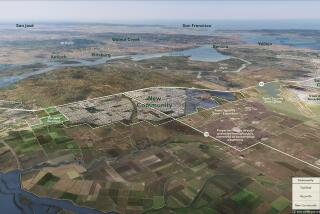Babbitt Hails Ahmanson Ranch as Model Solution for Housing
In his first comments as environmental liaison for the Ahmanson Ranch project in eastern Ventura County, former Interior Secretary Bruce Babbitt hailed the development as a model solution for Southern California’s housing needs.
Under fire from environmentalists and slow-growth activists who oppose the 3,050-home mini-city and have accused Babbitt of selling out his legacy as a conservationist, the former Cabinet member also defended his involvement with developer Washington Mutual.
“Unapologetically, here I am,” said the former Arizona governor and Clinton appointee, who signed on with the project in May.
“We’ve got two choices: one is no more housing and the other is to do it right. I’m not here to sell this project chapter and verse. [But] if you’re going to have development and provide housing, this is the optimal way to have it done.”
In an interview with The Times this week, Babbitt also said he wanted to put to rest suspicions that he was laying the groundwork for this consulting job when the U.S. Fish and Wildlife Service last year failed to list the San Fernando Valley spineflower found on the Ahmanson Ranch site as an endangered species.
“I’d never heard of the spineflower until I went to the Ahmanson Ranch . . . six weeks ago,” he said. “I’d never heard of Ahmanson Ranch when I was in office, either.”
The Ventura County Board of Supervisors approved the housing project in 1992. It has been delayed by more than a dozen lawsuits and the developers’ discovery of the spineflower and the threatened California red-legged frog. The developer has pledged to protect those species.
A handful of permits and environmental assurances still must be secured before construction can begin.
Babbitt’s connection to the project is through the Washington, D.C., office of Latham & Watkins, a law firm with which he has been affiliated since January. The firm has been advising the Ahmanson Ranch developers since 1999.
In his two months on the job, Babbitt has reached out to several critics of the project, including Santa Monica-based Heal the Bay, whose concerns focus on the effects of construction on waterways leading into Santa Monica Bay.
Babbitt’s involvement has given the developers a credibility boost, said Tony Pritzker, president of Heal the Bay.
“I think he’s trying to fight the good fight,” Pritzker said. “He’s trying to understand and see where they could address our concerns. It takes putting the pencil to paper a bit and trying to adjust around the project to address the issues. If Bruce can help us resolve our issues, there’s no reason we would object to the project.”
But Babbitt’s involvement hasn’t changed Mary Wiesbrock’s mind about the project.
Instead, said the director of local land conservation group Save Open Space, she’s changed her mind about Babbitt, who also has disclosed that he is representing Hearst Corp. on the central California coast and Irvine Co. in Orange County on land deals.
“He’s got his head in the sand,” Wiesbrock said. “The development we need needs to go in urban areas that need redevelopment, not on pristine land. We can never replace the Ahmanson Ranch, its grasslands, its oak trees, its endangered species.
“The man is a hypocrite,” she said. “How can he have these credentials where he saves the headwaters in Northern California but he lets the headwaters in Southern California go to pot? He’s blinded by the green of Washington Mutual’s money. He has no ethics, no credibility.”
Babbitt said there are solid reasons to support the project. Through development agreements and $27.5 million in public lands purchases, the project dedicates more than 10,000 acres to open space, creating a 6-1 ratio of preserved to developed land.
With its proximity to Calabasas and Woodland Hills, the project is partly flanked by other subdivisions, he said. It is compact and would include a substantial amount of affordable housing in addition to million-dollar homes. It promises 1,700 jobs, as well as shuttle service to jobs nearby, he said.
But Babbitt said he doesn’t expect to find a middle ground with all critics.
“When I was secretary of the Interior, [some of] the environmentalists hated me because I said we were going to work on solutions . . . that acknowledge there’s going to be development,” he said.
“There are some who will never be satisfied.”
More to Read
Sign up for Essential California
The most important California stories and recommendations in your inbox every morning.
You may occasionally receive promotional content from the Los Angeles Times.






